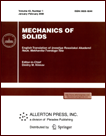 | | Mechanics of Solids
A Journal of Russian Academy of Sciences | | Founded
in January 1966
Issued 6 times a year
Print ISSN 0025-6544
Online ISSN 1934-7936 |
Archive of Issues
| Total articles in the database: | | 13362 |
| In Russian (Èçâ. ÐÀÍ. ÌÒÒ): | | 8178
|
| In English (Mech. Solids): | | 5184 |
|
| << Previous article | Volume 59, Issue 7 / 2024 | Next article >> |
| A.A. Adamov, I.E. Keller, Ya.N. Ivanov, and N.V. Utev, "Basic Tests and Identification of a Model of Viscoelastic Behavior of Elastomers under Finite Deformations," Mech. Solids. 59 (7), 3831-3843 (2024) |
| Year |
2024 |
Volume |
59 |
Number |
7 |
Pages |
3831-3843 |
| DOI |
10.1134/S0025654424606499 |
| Title |
Basic Tests and Identification of a Model of Viscoelastic Behavior of Elastomers under Finite Deformations |
| Author(s) |
A.A. Adamov (Institute of Continuous Media Mechanics of the Ural Branch of Russian Academy of Science, Perm, 614000 Russia, adamov@icmm.ru)
I.E. Keller (Institute of Continuous Media Mechanics of the Ural Branch of Russian Academy of Science, Perm, 614000 Russia, kie@icmm.ru)
Ya.N. Ivanov (JSC Novomet-Perm, Perm, 614065 Russia, Iaroslav.Ivanov@novometgroup.com)
N.V. Utev (JSC Novomet-Perm, Perm, 614065 Russia, Nikolai.Utev@novometgroup.com) |
| Abstract |
A program of basic tests and a method for identifying a model of viscoelastic behavior of a weakly compressible hyperelastic material experiencing finite deformations at room temperature are proposed. Three models using the linear hereditary operator of the generalized Maxwell body in combination with a two-constant approximation of the shear part of the elastic potential are considered, in which the decomposition of motion into elastic and viscoelastic parts is implemented in various ways. Viscoelastic constants are found according to the data of tests for free compression of cylindrical samples according to the deformation program with stages of loading at a constant speed and relaxation carried out on a rigid electromechanical testing machine. The volumetric compression module is being tested for constrained compression according to a cyclic program with stages of loading at a constant speed, unloading and holding. An algorithm for determining constants based on test data is proposed, which reduces the problem to solving a system of linear algebraic equations. The proposed method is applied to the determination of constants of the considered models for highly filled oil-resistant rubber. Cyclic tests were carried out for free compression of cylindrical samples with increasing strain levels of 10, 20, and 30% with two velocity values and exposures at fixed deformation and in the unloaded state for 900 s, as well as for constrained compression of the same samples to a stress of 127 MPa with exposures for 60 s. The models identified for a part of one cycle satisfactorily predict the change in stress during the execution of a further program, as well as when the deformation rate changes. To cover a larger range of deformations, the proposed program is implemented for ring tension testing. A not very good description of the inverse relaxation has been established, however, the use of combined test data for model identification does not help to correct this defect, which requires correcting the fundamental defects of the considered generalizations of nonlinear elastic models using a linear viscoelastic operator. |
| Keywords |
viscoelasticity, hyperelasticity, weakly compressible materials, elastomers, identification, testing |
| Received |
15 November 2024 | Revised |
24 November 2024 | Accepted |
25 November 2024 |
| Link to Fulltext |
|
| << Previous article | Volume 59, Issue 7 / 2024 | Next article >> |
|
 If you find a misprint on a webpage, please help us correct it promptly - just highlight and press Ctrl+Enter If you find a misprint on a webpage, please help us correct it promptly - just highlight and press Ctrl+Enter
|
|

 Russian
Russian  English
English